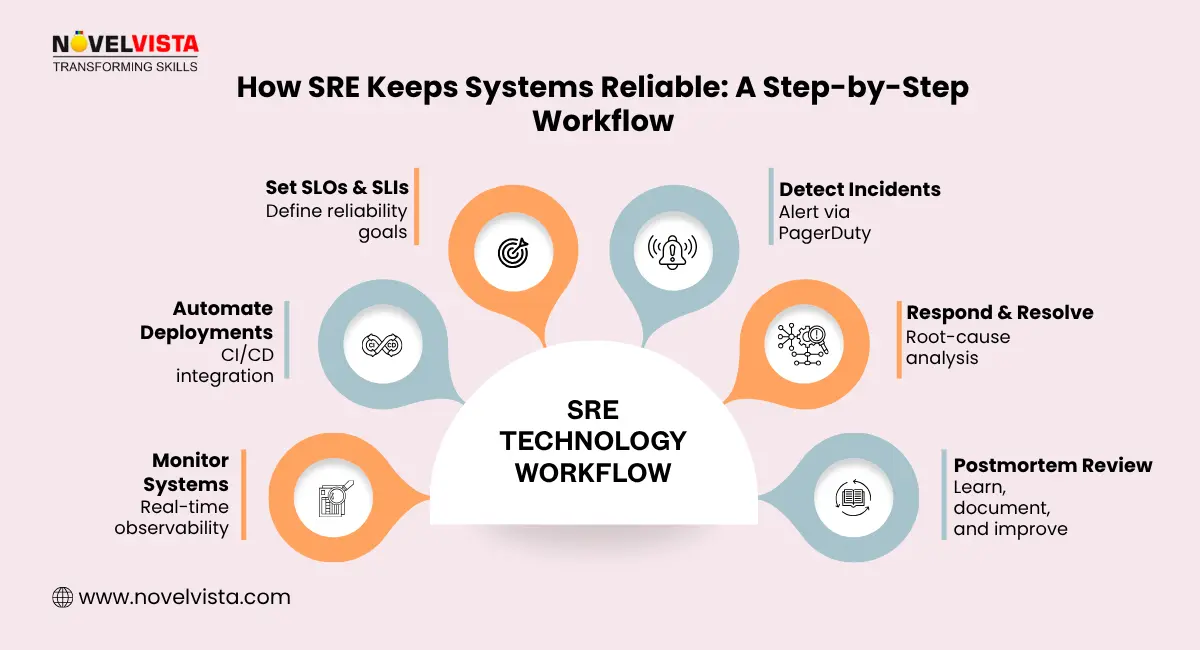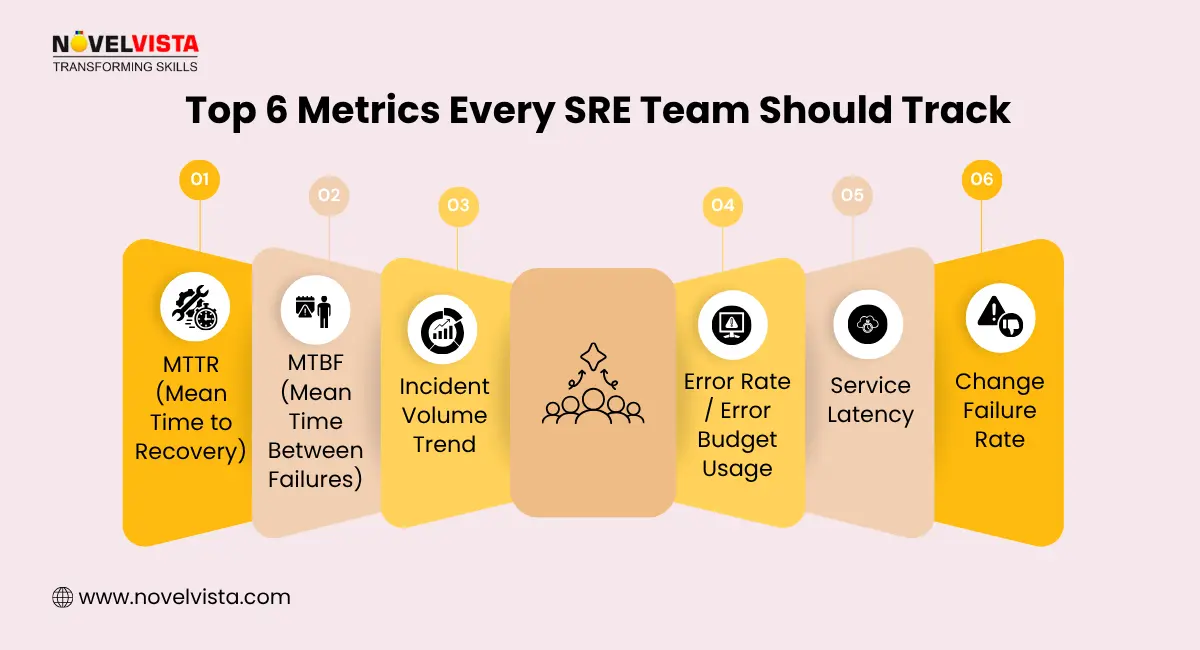- What Does SRE Mean in Technology?
- How SRE Works: The Core Principles of Site Reliability Engineering
- Key Responsibilities of an SRE Engineer
- Essential SRE Technologies and Tools You Should Know
- Benefits of Implementing SRE in Technology
- SRE Career Path: Roles, Skills, and Growth Opportunities
- Common Challenges in SRE Implementation
- Conclusion: SRE in Technology
Ever wondered how companies like Google, Netflix, or Amazon keep their services running smoothly 24/7 — even when millions of users are logging in, streaming, or shopping all at once? That’s where the magic of Site Reliability Engineering (SRE) in technology.
If you’ve been hearing the term but aren’t exactly sure what is SRE in technology, here’s the simple answer — it’s the practice of combining software engineering and IT operations to build reliable, scalable, and automated systems. In short, SRE makes sure that technology doesn’t just work; it keeps working no matter how big or complex things get.
SRE is gaining massive attention because modern companies can’t afford downtime. A single outage can cost millions, hurt brand trust, and frustrate customers. Through this guide, we’ll break down everything — from SRE meaning in tech, how it works, the tools involved, and why it’s becoming one of the most important roles in IT today.
What Does SRE Mean in Technology?
Let’s clear up the confusion — what does SRE mean in technology?
In simple words, SRE or Site Reliability Engineering is a way to apply engineering principles to make IT systems more reliable and efficient.
The concept was first developed at Google, where they noticed that developers (Dev) wanted to push updates quickly, while operations (Ops) teams focused on keeping systems stable. To balance this, they created SRE — a middle ground that uses automation, monitoring, and smart processes to keep both sides happy.
Here’s what SRE meaning in tech really boils down to:
- Balance between speed and stability: Developers build new features fast, and sre in technology ensures those updates don’t break existing systems.
- Engineering mindset for reliability: Instead of manually fixing problems, SREs build tools that prevent issues in the first place.
In other words, SRE in technology brings together the best of both worlds — innovation from developers and stability from operations.
How SRE Works: The Core Principles of Site Reliability Engineering
Now that you know what SRE is, let’s talk about how sre in technology works. SRE runs on a set of guiding principles that make it measurable, consistent, and scalable across teams. Here are the core principles explained in simple terms:

- Service Level Indicators (SLIs): These are the actual metrics used to measure performance — like uptime, latency, or request success rates. SLIs tell you how reliable your system really is.
- Service Level Objectives (SLOs): These are the targets you aim to achieve based on SLIs. For example, an SLO could be 99.9% uptime per month.
- Error Budgets: Instead of demanding perfection, SRE defines how much failure is acceptable. If your error budget is used up, new releases pause until reliability improves.
- Automation & Monitoring: Automation reduces manual work. Monitoring ensures that issues are detected before users even notice them. Together, they form the backbone of SRE efficiency.
- Blameless Postmortems: When something fails, teams focus on what went wrong, not who. This builds a culture of learning and trust.
- Continuous Improvement: SRE is never “done.” Teams keep analyzing data, updating tools, and improving processes to make systems better every day.
These principles turn reliability from a vague concept into something measurable and actionable — that’s the power of SRE in tech.
Must Read: Site Reliability Engineering Fundamentals
Key Responsibilities of an SRE Engineer
If you’re wondering what an SRE engineer actually does day to day, here’s the breakdown:
- Build and maintain scalable infrastructure: SREs design systems that can handle massive loads without crashing.
- Monitor performance and uptime: They set up alerts, dashboards, and logs to ensure services stay healthy.
- Automate deployments and incident responses: Repetitive tasks are automated to save time and reduce human error.
- Define and track SLAs, SLOs, and SLIs: These metrics help measure how reliable and user-friendly the service is.
- Collaborate with development teams: SREs work closely with developers to design systems that are easy to maintain and scale.
- Manage capacity planning and cost optimization: They ensure resources are used efficiently without overspending.
Simply put, SRE engineers are the unsung heroes of tech — they make sure that your favorite apps and websites stay fast, reliable, and available all the time.
SRE Certification Levels Explained
Learn the exact tools, skills, and roadmap top engineers use
to fast-track their reliability careers.
Essential SRE Technologies and Tools You Should Know
When it comes to SRE in technology, tools are everything. They help automate tasks, monitor systems, and fix issues before users even notice something’s wrong. Mastering the right SRE technologies can make a huge difference in how effective an engineer is.

Let’s look at the most widely used SRE tech tools, grouped by purpose:
- Monitoring & Observability: Prometheus, Grafana, and Datadog help track system health, latency, and uptime. They give teams real-time visibility into how services perform.
- Automation & Configuration: Terraform, Ansible, and Puppet are used to manage infrastructure as code — meaning you can deploy entire systems with a few commands.
- Incident Management: PagerDuty and Opsgenie alert the right people instantly when something breaks, helping teams respond faster.
- Logging & Tracing: ELK Stack (Elasticsearch, Logstash, Kibana), Splunk, and Jaeger make it easier to understand why an incident happened and trace its root cause.
- Cloud Platforms: AWS, Google Cloud Platform (GCP), and Azure are where most SREs spend their time. They manage deployments, backups, and scaling.
These SRE technologies form the backbone of reliability in modern organizations. Knowing how to use them makes you not just efficient, but indispensable in large-scale IT environments.
Also Read: Top Ranking SRE Tools in 2025Benefits of Implementing SRE in Technology
So, why are companies investing so much in SRE? Because the results speak for themselves. Adopting SRE in tech helps organizations turn reliability into a predictable, measurable practice rather than a guessing game.
Here’s what businesses gain when they apply SRE in technology:
- Fewer outages and downtime: Automation and monitoring mean potential problems are spotted early and fixed quickly.
- Faster issue resolution: With clear metrics (SLIs and SLOs), engineers know exactly where to look when something fails.
- Predictable performance: Consistent system behavior leads to better user experiences and higher trust.
- Improved team collaboration: SRE breaks the wall between developers and operations — both teams work toward the same goal: reliability.
- Better customer satisfaction: Reliable systems mean happier customers who stick around longer.
In short, SRE goes beyond just keeping servers running — it’s about delivering stability, trust, and quality at every level.
SRE Career Path: Roles, Skills, and Growth Opportunities
Now that you understand the importance of SRE, let’s talk about the exciting part — the career opportunities.
The demand for skilled SRE professionals is skyrocketing because companies need experts who can make sure systems stay up and running. Whether you’re a developer or a sysadmin, transitioning to SRE can open doors to some of the best-paying and most impactful roles in tech.
Here’s how a typical SRE career path looks:
- Entry-level: Systems Engineer or Operations Engineer — learning about automation, scripting, and monitoring tools.
- Mid-level: Site Reliability Engineer or Infrastructure Engineer — managing production systems and defining reliability metrics.
- Advanced-level: SRE Lead, Reliability Architect, or Head of Reliability — overseeing reliability strategy and mentoring teams.
Check Out: Complete SRE Roadmap to Get Started in 2025
Key Skills Every SRE Needs:
- Automation and scripting knowledge (Python, Go, or Shell)
- Strong understanding of cloud platforms (AWS, Azure, GCP)
- Familiarity with monitoring and alerting tools
- Experience in managing SLAs, SLOs, and SLIs
- Problem-solving and analytical mindset
Having certifications in DevOps, Cloud, or SRE-specific programs can fast-track your growth. As technology continues to evolve, SRE is becoming one of the most future-proof career paths out there.
Common Challenges in SRE Implementation
While SRE brings incredible value, implementing it isn’t always smooth. Many organizations struggle during the initial adoption phase.
Here are some common hurdles and how to handle them:
- Balancing innovation with reliability: Teams often push new features too fast, ignoring reliability goals. The solution? Define clear Service Level Objectives (SLOs) and enforce error budgets to maintain balance.
- Lack of automation culture: Manual processes lead to inconsistency. Automate routine tasks wherever possible — deployment, scaling, testing, even alerts.
- Undefined SLIs or SLOs: Without measurable targets, you can’t track reliability. Start small — pick two or three service level indicators that really impact users.
- Skill and resource gaps: Not every team has SRE experts. Encourage training and certification programs to build in-house talent.
Once these challenges are addressed, organizations can unlock the full potential of SRE in technology — achieving both innovation and reliability without compromise.
Conclusion: SRE in Technology
To wrap it up — what is SRE in technology? It’s the bridge that connects development speed with operational stability. It’s how top companies ensure their systems stay reliable, scalable, and efficient.
As more organizations move to the cloud and adopt complex distributed systems, SRE in tech will only become more essential. It’s not just a role; it’s a mindset that every modern IT team needs.
If you’re aiming to grow your career in IT operations or system reliability, learning SRE principles and tools is the best place to start.
Because in today’s digital world, reliability isn’t optional — it’s everything.
Next Step: The Future of SRE
Ready to kickstart your SRE journey? Enroll in NovelVista’s SRE Foundation Certification Training — your pathway to mastering reliability engineering principles, automation practices, and real-world resilience strategies. Our expert-led sessions, hands-on labs, and industry case studies ensure you gain practical, job-ready skills.
Join NovelVista today and elevate your career as a certified Site Reliability Engineer — where reliability meets innovation!
Frequently Asked Questions
Author Details

Vaibhav Umarvaishya
Cloud Engineer | Solution Architect
As a Cloud Engineer and AWS Solutions Architect Associate at NovelVista, I specialized in designing and deploying scalable and fault-tolerant systems on AWS. My responsibilities included selecting suitable AWS services based on specific requirements, managing AWS costs, and implementing best practices for security. I also played a pivotal role in migrating complex applications to AWS and advising on architectural decisions to optimize cloud deployments.
Confused About Certification?
Get Free Consultation Call









